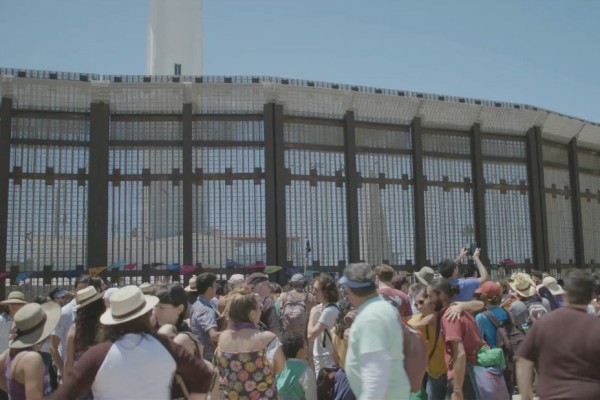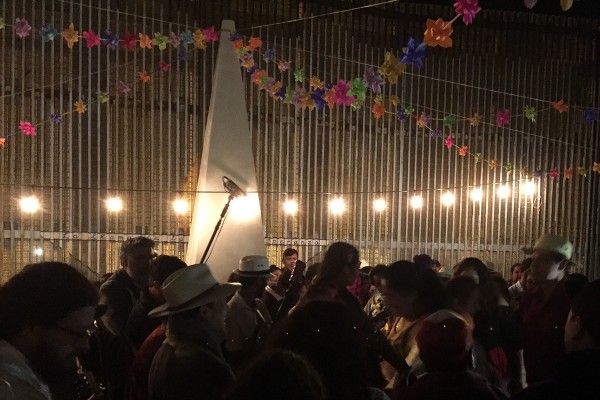Bay Daniel Sheehy Folklife Magazine, Smithsonian
Washingbton, DC

The current border wall that separates Mexico from the United States, is seen from the side of San Diego, California. Photo: Folklife
Rising out of the Pacific Ocean, the U.S.-Mexico border wall cuts through the beachfront at Playas de Tijuana. It ascends the hill to bisect a small plot of sand and concrete known by two names: El Parque de la Amistad in Tijuana, Mexico, and Friendship Park in San Diego, California.
Against the southern side of the wall stands a nineteenth-century obelisk marking this as Mexico’s northwesternmost reach. A plaque reminds visitors that this limit on Mexico’s territory resulted from the 1848 Treaty of Guadalupe Hidalgo, which ended the war with the United States and ceded half of Mexico’s territory to its northern neighbor’s ambitions of “manifest destiny.” Despite the thorns of history, the fence on the Mexican side of the border wall is covered with bright murals proclaiming friendship and hope for togetherness across borders.
For many visitors on the American side, “friendship” is the last thing the site brings to mind. Parallel twenty-foot fences enclose the space. Visitors pass the bars of the first wall’s gate under the watchful eye of the Border Patrol. The second wall proves more opaque; a drab, thick metal mesh makes it difficult to see who stands on the other side.
Older visitors might recall a different sort of view. First Lady Pat Nixon inaugurated the park in 1971, when separated friends and family could reach through the fence to shake hands or offer a touching caress to a grandchild or parent. Now, in a small act of humanity overcoming divisiveness, many visitors jest bittersweetly about the “traditional border handshake”―greeting one another by touching the tips of their pinkies through the mesh.
But once a year, people gather here for a joyous occasion: the Fandango Fronterizo, or border fandango. For the last ten years, revelers have come to make music, dance, meet friends, and celebrate, as well as express their feelings about U.S. immigration policy. They are brought together by two movements from both sides of the border―one musical and cultural, the other social and political.

A look through the border fence between San Diego, California (USA) and Tijuana, Baja California (México). Photo: Folklife.
Mexico’s fandango celebration tradition is rooted in the son jarocho music, dance, poetry, and social rituals of the southern coastal plain of Veracruz. In the United States, many fandangueros have applied their music to building community and protesting U.S. immigration policy.
At the 2017 gathering on May 27, Fandango Fronterizo organizer Adrian Florido explained that the event is not intended to be political per se, but rather to create a cultural platform to bring people together. Some proclaimed their presence as an act of political resistance, overcoming the ugliness of the wall that divides people through acts of joyful music making and fellowship. Carolina Martinez expressed the intention as healing―“celebrating a place that causes lots of pain for the immigrant community, and transforming it into a fiesta.” For Cameron Quevedo, it was an opportunity for self-discovery, saying, “Music is a wonderful gateway, a door into culture, into sharing spaces, a way to reconnect to my roots and to meet other folks.”
On the U.S. side, the activities were more controlled and symbolic. Music started promptly at 11 a.m. and ended precisely three hours later, per the U.S. rules. Small dance platforms called tarimas were placed next to each other on either side of the fence, and people danced together often not knowing who their partners were. Musicians on both sides played a shared repertoire of traditional sones jarochos. People chatted around the periphery.
A number of notable artists were among the couple hundred attendees in May. Hip-hop singer Maya Jupiter, her partner and fellow musician Aloe Blacc, and their baby enjoyed the music and conversation. They support the event through their organization Artivist Entertainment, “representing artists who inspire positive social change through music and art.” Chilean singer Ana Tijoux explained how the Fandango Fronterizo comes at an important time in history when people must think in international terms. Palestinian hip-hop artist Shadia Mansour came to learn from the event and express her solidarity with oppressed people. At 2 p.m., the event abruptly ended, and people began their trek back across the sands to the distant parking lot.

Celebrating in full Fandango in front of the fence that separates Mexico from the United States. Photo: Folklife
Many others made their way to the Mexican side for an outdoor evening panel conversation on the occasion’s issues and artists, followed by special performances and a party. For the tenth anniversary, organizers raised funds to bring certain anchors of the fandanguero movement, members of the Vega family of Boca de San Miguel ranch in rural Veracruz. Patriarch Andrés Vega and his son Octavio hail from a region known as the cradle of the fandango tradition and have been key players in son jarocho’s revival since the early 1980s.
Food was served. T-shirts were sold. Ana Tijoux and Shadia Mansour offered free tribute performances. Then the Vega family and a crowd of people with instruments in hand assembled as the sun set over the Pacific. The “real” fandango began, with dozens of musicians and dancers joining in the social dance ritual. The magic of the fandango once again did what it has done for centuries: brought people together to knit a closer sense of togetherness. The sounds of guitars, voices, and dancing feet went late into the night. Only then did exhausted attendees return home, memories of the event and its meaning echoing in their hearts and minds.
Back at his ranch, Octavio Vega reflected on the hope inspired by the Fandango Fronterizo. “When reasonable people come together around a shared purpose, obviously we will come to an understanding, right?”
Daniel Sheehy is director and curator emeritus of Smithsonian Folkways Recordings.
To watch the Video Click aquí.













